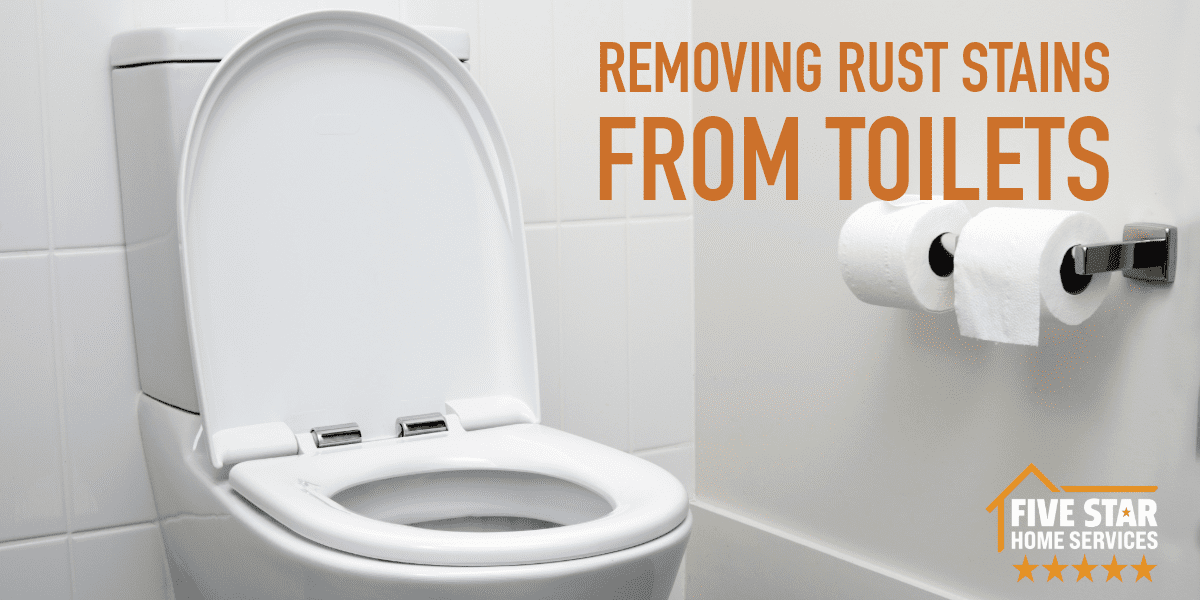Maybe you’ve noticed that your toilet is starting to look unpleasant because it has developed a discoloration either in the tank or bowl. Mineral deposits, mold, and bacterial growth are common culprits of stain formation.
Causes of Rust
Let us take a quick look at the different causes of stains that develop as rings in the bowl or general discoloration in the tank itself:
Iron in water supply
You can tell if iron is the cause of the stain if it shows a red or brown color. This problem also comes with issues regarding calcium deposits, indicating the hardness of water. In short, if you have hard water, which means increased mineral deposits, you may have iron in the water, too. These red stains may also indicate that corrosion has occurred in your pipes that are often galvanized steel. If the water flow is restricted, the pipes may be damaged due to rust.
Bacteria
The most common airborne bacteria, Serratia marcescens, can impart a pink-gray hue on moist surfaces, especially in bathrooms. Toilet bowls, shower tiles, sink drains, and shower heads may develop this pink residue. Although mostly harmless to healthy people, these bacteria have been known to trigger urinary tract infections and pneumonia.
Tannins
When present in the water, these occur as a breakdown of organic matter and appear pale yellow or yellow-brown (similar to tea). Stains caused by these are often not easily removed by the water filtration process.
Calcium and magnesium limescale
This is one of the most common buildups that can develop as white or light-grey rings along water lines (for example, in your toilet bowl). They develop when water sits for a long time and are likely to develop in toilets that are not flushed often or are not used frequently.
Mold and mildew
These terms are often used interchangeably, and they commonly appear where the environment is moist. Mildew is differentiated from mold based on its appearance, which usually starts off white and powdery but turn yellow brown, or black later on. Mildew also grows on flat surfaces, so its flat appearance also distinguishes it.
On the other hand, mold can appear black, blue, green, or red and is more toxic in terms of health effects, particularly black mold.
Manganese levels in water
They can appear as brown stains
You’ve heard of the saying “an ounce of prevention is worth a pound of cure.” Regular maintenance is key to prevention of rust or stain formation in toilets. Some preventive measures include:
- Regular cleaning – Keeping up with a schedule to clean the toilets is way effective in stopping stains from forming in the first place. Clean with a toilet bowl cleaner and a toilet brush for scrubbing. This should be done weekly, or more frequently if the bathroom is shared among a number of people. Once a month, cleaning with vinegar is recommended to prevent lime scale deposits and toilet rings from forming.
- Flush frequently – Daily flushing of toilets is recommended especially those that don’t get used often (such as in guest rooms). This prevents rings and pink stains from setting in the toilet bowl. For toilets that are used rarely, it would be better to shut off the water supply to that fixture. Clean the toilet first then let dry.
- Coat toilet bowl with cleaner – In order to prevent bacteria from forming, you can apply toilet bowl cleaner under the rim and around the bowl, then let that sit for a while. Scrub before flushing.
- Clean the toilet tank – You can do this twice a year, and is good practice in preventing the formation of rust stains and stains caused by mold or mildew. Pour some vinegar in the half-drained tank then let it sit for half a day. Flush then scrub the insides of the tank with a scrub and disinfectant solution. Additionally, non-corrosive and naturally chemical-free tank tablets help keep away bacteria every time you flush.
Now that we have covered the causes of stains and how to prevent them from forming, we can move on to the steps we can do to remove stains, particularly rust stains, that have already formed in the toilet. Because rust stains are commonly caused by rust content in the water supply itself, the likelihood of the stain appearing in the toilet bowls is increased the more that the toilet is used. Therefore, a rust removal system installed at the main water supply can be helpful. Furthermore, because rust binds to porcelain (and glass), it is harder to remove these stains the longer you let them be. The following are some of the
Ways You Can Get Rid of Rust Stains
Vinegar (and baking soda)
The most effective cleaners for rust stains are acid-based, and the tried-and-true method of vinegar and baking soda will work on most mild to moderate toilet stains, even rust.
Steps to take:
1. Measure out 1 cup of vinegar and pour it into the toilet bowl, coating rust-stained surfaces. Let it sit for a couple of minutes.
2. Apply 1 cup of baking soda on the same surfaces of the toilet bowl, then pour 2 cups of vinegar. Let sit for 10 minutes.
3. Repeat steps 1 and 2, letting the solution sit for 30 minutes this time.
4. Scrub the stains with a brush then flush the toilet. Most, if not all, of the stains should already be gone.
5. Alternatively, you can also scrub the toilet clean with a solution of equal parts vinegar and water.
Baking soda and lemon juice or water
Make a paste out of these two items and apply onto the rust stains in the toilet blow. After letting it sit for at least an hour, scrub with a toilet brush.
Borax and vinegar
When combined, these two produce a very effective cleaner against rush stains. Pour about 1/4 cup borax into the toilet bowl, followed by 1 cup of vinegar. Let this sit for 20 minutes. Scrub with a toilet brush, then flush. This method can also be done by making a paste of borax and vinegar and applying it to the rust stains.
Other effective acidic solutions that may be applied on rust stains are common items such as Coca-Cola (contains phosphoric acid) and cream of tartar, which is commonly used in baking (contains tartaric acid). Extraordinarily tough and difficult stains may need more powerful cleaning agents that are more commercial grade. One example of this is CLR (Calcium, Lime, and Rust Remover). This is an industrial-strength cleaner that you can buy in stores. CLR is known to be fast-acting and powerful because it contains more acids as its special ingredients, such as lactic acid and gluconic acid. Follow the directions on the product label for best results. Do not be tempted to use bleach to remove rust stains. Although bleach is a powerful chemical agent, it does the opposite effect that you intend— it fixes the stains rather than remove them, thus, making it difficult to remove them.
Rust stains and other discolorations in the toilet bowl or tank are unsightly but the available remedies can get you out of the misery of having to see them. One thing to remember, though, is that rust due to pipe damage may require an inspection, repair, or installation of new pipes by a certified plumber. Count on Five Star Home Services for your plumbing needs or any questions. Call us now at (833) 405-8009.

